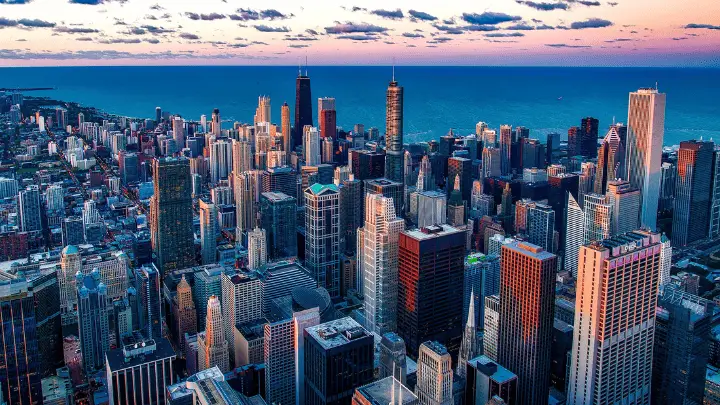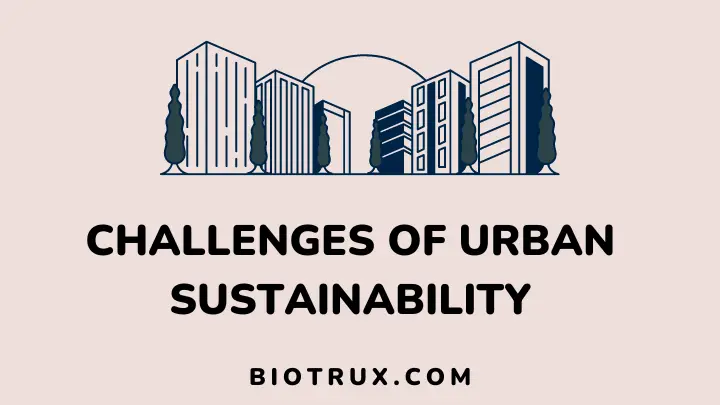Every city is a living, breathing organism. It has to breathe, it has a heartbeat, and it must grow. But, when we look at it from a top-down or bottom-up perspective, cities are only sometimes sustainable. There are several challenges that urban sustainability faces.
Urban sustainability is among the most debated topics, from congestion, urban pollution, and climate change to energy consumption, efficient transport, and housing. It seems even less promising than ever due to the rise of large-scale construction projects in cities.
This article will explore urban centers’ challenges in pursuing sustainability, including waste management, pollution, and renewable energy. Join me as I uncover the hurdles that urban areas must overcome to create a more sustainable future.
1. Sustainable Resource Management
Since the 1990s, urban sustainability has become a popular concept. Recently, it has become more widely recognized as a field of study due to its research agenda and methodologies.
However, many challenges still need to be overcome before sustainable development can be achieved on a large scale. The first challenge to urban sustainability is to manage our resources wisely.
We need to understand how and where our natural resources are used and how they can be used more efficiently. This includes understanding what materials we use, where they come from, their environmental impact, and how they can be recycled or reused.
We also need to consider how our cities function as ecosystems that interact with each other and the natural environment.
2. Urban Sprawl
Cities today face the challenge of urban sustainability. Urban sprawl refers to an uncontrolled expansion of cities. The global population is increasing, with more than half of the world’s people living in cities.
Urbanization is a two-edged sword in terms of urban sustainability. On the one hand, it promotes economic growth and development by attracting enterprises, creating job opportunities, and increasing many people’s quality of life.
However, with the massive migration of people into cities comes a slew of difficulties that endanger urban sustainability. The increased demand for housing, infrastructure, and resources strains the environment and can lead to overcrowding, pollution, and inadequate access to basic services.
3. Air and Water Quality
Air pollution poses an invisible threat.
Urban centers are notorious for their high levels of air pollution arising from vehicle emissions, industrial processes, and construction activities. Poor air quality directly impacts public health, leading to respiratory diseases, heart problems, and reduced quality of life for city residents.
The problem of water contamination
Inadequate waste management and improper disposal of chemicals lead to water contamination in urban areas. Polluted water sources pose a serious threat to both the environment and human health. Addressing this challenge requires efficient water treatment systems and strict enforcement of environmental regulations.
4. Ecological Footprints of Cities
One of the challenges of urban sustainability is to reduce the ecological footprint of cities. The ecological footprint is the total amount of land required to produce goods and services consumed by people every year.
A city’s ecological footprint depends on population size, economic output, and consumption patterns. The large concentration of people and infrastructure in cities results in greater resource consumption and environmental effect.
This depletes natural resources and damages ecosystems. The goal is to discover strategies to lessen cities’ ecological footprint while serving urban people’s needs and aspirations.
This necessitates a comprehensive approach that includes sustainable urban planning, efficient resource management, and promoting environmentally friendly practices among inhabitants. It also needs collaboration among government, businesses, and communities to find innovative solutions for sustainable urban life.
5. Energy Use
Efficient energy use is one of the biggest challenges of urban sustainability. As cities and populations develop, so does the energy demand. This strains existing energy resources and infrastructure, resulting in problems such as rising carbon dioxide emissions and higher energy bills.
Finding sustainable and alternative energy sources is critical to minimizing environmental damage and ensuring long-term supply. Furthermore, cities consume significant energy because of the large concentration of buildings, transit networks, and industries.
Reducing energy consumption and promoting renewable energy sources are vital for urban sustainability. It is important to prioritize these efforts to create a more environmentally friendly and sustainable future for our cities.
6. Insufficient Policy Implementation Efforts
One of the most pressing challenges of urban sustainability is the need for more implementation of policies. While cities must have comprehensive plans and strategies in place, the actual execution of these policies often needs to be improved.
This can be attributed to a variety of reasons. Firstly, there may be a need for more political will or support from key stakeholders, resulting in a lack of resources and funding allocated toward implementation efforts.
Additionally, bureaucratic barriers may hinder the progress of policy implementation. Also, the complexity and interconnectedness of urban systems make achieving a holistic approach to sustainability difficult.
As a whole, addressing urban sustainability challenges requires improved policy implementation and effective integration of sustainable practices.
7. Inadequate Infrastructure and Services
It can be further divided into Aging infrastructure and insufficient green spaces.
The struggle to keep up with aging infrastructure
Many cities must grapple with outdated infrastructure systems that must be equipped to handle modern demands. Inadequate transportation networks, unreliable water supply, and outdated waste management systems hinder sustainable growth and development.
Insufficient green spaces
Urban green spaces contribute to improved air quality, biodiversity, and the overall well-being of urban residents. Green spaces and recreational areas in urban environments are necessary for residents access to nature. These areas provide recreational opportunities and contribute to improved air quality and mental well-being.
8. Waste Management and Recycling
Achieving urban sustainability has become difficult because of waste management and recycling. The waste generated has increased dramatically with fast urbanization and an expanding city population.
If not adequately handled, this threatens the environment and public health. The problem is creating efficient waste management systems that can handle the volume of waste generated while ensuring correct disposal or recycling.
Furthermore, recycling is critical for reducing the pressure on landfills and conserving resources. However, successful waste management and recycling procedures necessitate major investment, infrastructure, and public awareness.
It is critical to address these issues to maintain our cities’ long-term viability.
9. Affordable Housing and Inclusivity
Affordable housing and inclusion are undoubtedly difficult hurdles to attaining urban sustainability. As cities expand and populations grow, so does the need for homes.
However, housing expense is frequently out of reach for many individuals and families, resulting in a lack of inclusion in metropolitan areas. This creates a barrier between those who can and cannot afford to reside in the city.
To achieve genuine urban sustainability, policies and measures that promote affordable housing and ensure inclusion for all people must be implemented. Cities can create a more egalitarian and sustainable future for all.
10. Climate Change Vulnerability
Cities’ vulnerability to climate change is a serious challenge to urban sustainability. Cities worldwide are becoming increasingly vulnerable to the effects of climate change as they grow and develop.
Rising temperatures, extreme weather events, and sea-level rise are just a few of the effects of climate change that cities must deal with. These changes can cause various problems for cities, such as increased flooding, heat waves, and infrastructure damage.
Urban regions are particularly vulnerable to climate change because of their dense populations, reliance on essential infrastructure, and lack of flexibility. Cities must develop policies to reduce vulnerability and build resilience to achieve urban sustainability in the face of climate change.
This includes investing in green infrastructure, enhancing urban planning and design, and enacting regulations that support renewable energy and sustainable mobility.

FAQs
What is urban sustainability?
Urban sustainability refers to developing and maintaining cities prioritizing environmental protection, social equity, and economic viability to ensure a high quality of life for current and future generations.
What are some examples of climate-resilient infrastructure in urban centers?
Climate-resilient infrastructure includes elevated buildings, flood barriers, green roofs, and water management systems.
How can cities promote community engagement in sustainability efforts?
ACities can organize workshops, create community gardens, and involve residents in decision-making.
What is the circular economy, and how does it relate to urban sustainability?
The circular economy focuses on minimizing waste and promoting the efficient use of resources. In the context of urban sustainability, this involves implementing recycling programs, upcycling initiatives, and promoting sustainable consumption patterns.
Final Thoughts: The Way Forward
Yes, it is important to reduce greenhouse gases and promote sustainability. But, as we’ve seen, it can only be done by addressing the numerous challenges facing cities. Since problems of this magnitude rarely have simple or easy solutions, leaders must set realistic goals and provide concrete plans for dealing with them.
Furthermore, when we talk about sustainability in the context of urban communities, it’s easy to get lost in a sea of data and statistics. But what does it all mean? How do we use this information to devise a sustainable plan to help our cities thrive?
Educating the public is key. Ultimately, the solution is in the hands of the people, so we need to educate ourselves first to see a positive change.
You can also learn more about urban sustainability trends
Thanks for reading.

